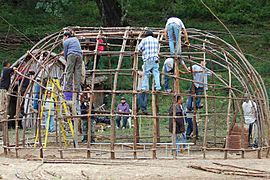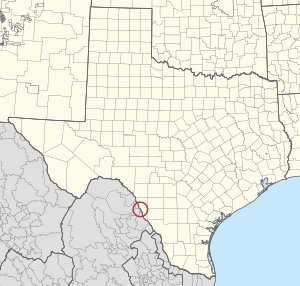Kickapoo Traditional Tribe of Texas facts for kids

|
|
| Total population | |
|---|---|
| 960 | |
| Regions with significant populations | |
| Languages | |
| English, Kickapoo | |
| Religion | |
| traditional tribal religion | |
| Related ethnic groups | |
| other Kickapoo people and Meskwaki, Sauk, and Shawnee people |
|
Kickapoo Indian Reservation
|
|
|---|---|

Location in Texas
|
|
| Tribe | Kickapoo Traditional Tribe of Texas |
| Country | United States |
| State | Texas |
| County | Maverick |
| Headquarters | Rosita South |
| Government | |
| • Body | Tribal Council |
| Population
(2017)
|
|
| • Total | 416 |
| Website | kickapootexas.org |
The Kickapoo Traditional Tribe of Texas is a Native American tribe. They live near Eagle Pass, Texas. This tribe is special because the United States government officially recognizes them. They use money from their businesses, like a casino, to help their people. This money pays for homes, schools, and other important services for tribe members. Not long ago, in the 1980s, many Kickapoo people lived under a bridge! Now, they are a great example for other Native American tribes. They show how a tribe can become strong and help its members. The Kickapoo Traditional Tribe is one of only three tribes in Texas that the U.S. government officially recognizes.
Contents
Kickapoo Reservation in Texas
The Kickapoo Indian Reservation in Texas is a special place. It is located in western Maverick County. You can find it right on the Rio Grande river. This river forms the border between the U.S. and Mexico. The reservation is just south of the city of Eagle Pass. It is part of a community called Rosita South.
The land area of the reservation is about 48 hectares (118 acres). Around 960 tribal members live there. Many also live on tribal lands in Nacimiento, Mexico. The tribe often holds important ceremonies in Mexico. To be a member of the tribe, a person must be at least one-fourth Kickapoo.
Kickapoo Language and Communication
Many members of the Kickapoo tribe speak several languages. They often speak English and Spanish. They also speak the Kickapoo language. This language is part of the Algonquian language family. It is related to the Fox language.
The Kickapoo people also have a unique way of communicating. They use something called Kickapoo whistled speech. This is a special way to talk using whistles.
How the Tribe Supports Itself
The Kickapoo Traditional Tribe of Texas has many businesses. These businesses help the tribe earn money. This money then goes to support the tribe members.
Some of their businesses include:
- The Kickapoo Lucky Eagle Casino Hotel: This is a large casino and hotel.
- The Lucky Eagle Convenience Store: A local shop for everyday needs.
- Kickapoo Empire: This is a special business that works with the government.
- A pecan farm: They grow and sell pecans.
- Ranches: They own ranches in both the U.S. and Mexico.
- A gas station: They have a gas station in Mexico with PEMEX.
The money from these businesses helps the tribe provide many services. These services include education, housing, and health programs. They also offer other social services to help their community.
A Brief History of the Kickapoo Tribe
The history of the Texas Kickapoo tribe is closely tied to Texas itself. In the early 1800s, the Spanish government invited the tribe to settle in Texas. Spain hoped the Kickapoo and other Native American tribes would help protect the area. They wanted a barrier against American settlers moving in.
However, by 1839, most Kickapoo people had left Texas. They moved to Mexico or Indian Territory (now Oklahoma). This happened because a treaty proposed by Sam Houston was never officially approved.
In 1852, the Mexican government gave the tribe land. This land was in Nacimiento, Coahuila, Mexico. Over the years, tribal members would often return to Texas. They worked as seasonal farmers.
The tribe gained official recognition in Texas in 1977. Then, in 1982, they were recognized as a subgroup of the Oklahoma Kickapoo Indian Tribe. This was a big step! It allowed them to get their own reservation. This reservation would be managed by the Bureau of Indian Affairs, not the state of Texas.
Finally, in 1985, the tribe formed a special relationship with the U.S. federal government. This relationship gave them the 118 acres in Eagle Pass they live on today. They have kept this important relationship ever since.

